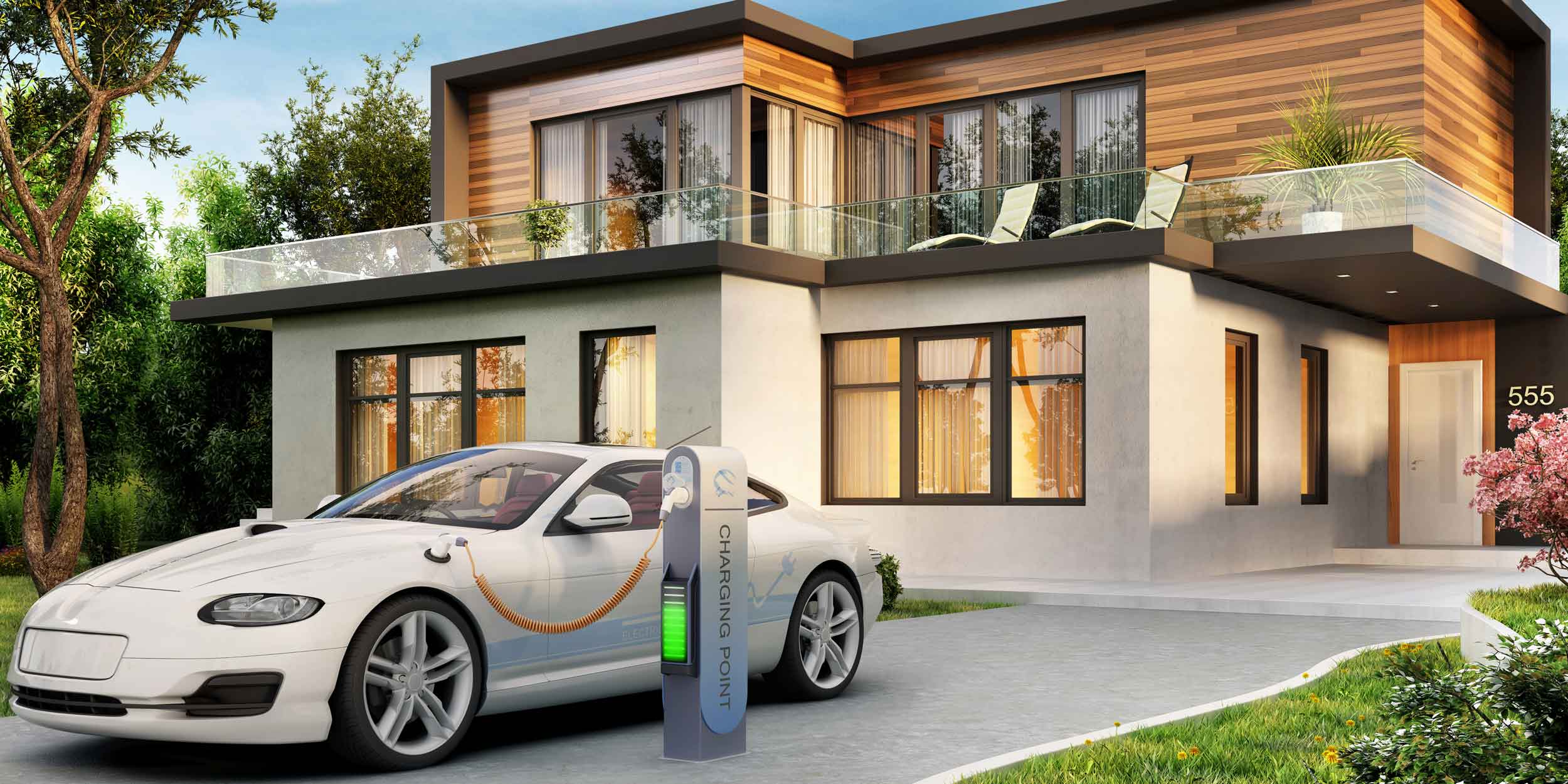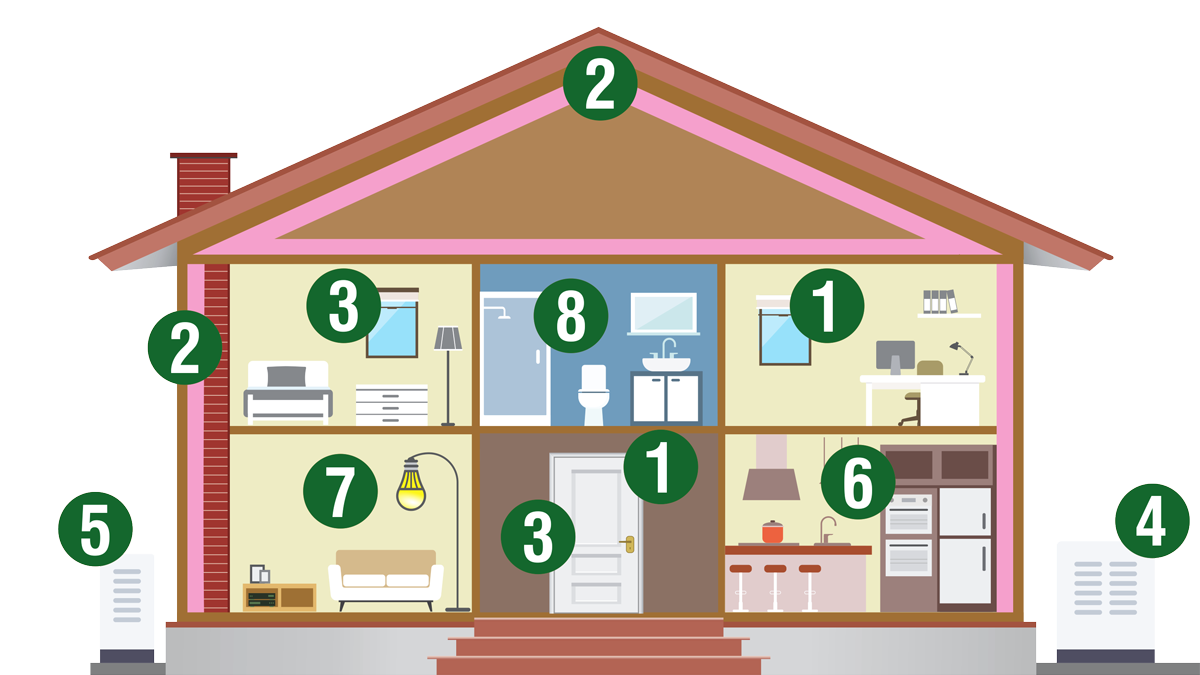What is an Energy-Efficient Home?
Any home, no matter when it was built, can become more energy-efficient. Modern construction standards have improved the energy efficiency of newer homes, but all homes (and especially older homes) can be upgraded to improve their energy performance as well. And, no matter where we live, we can all practice energy-efficient habits.

Top 9 Features of an Energy-Efficient Home

- Air sealing (around windows, doors, electrical outlets, vents)
- Well-insulated (walls, attic, basement)
- High-performing ENERGY STAR® windows and doors
- High-performing or ENERGY STAR® equipment (furnace, air-conditioner, water heater)
- High-performing ENERGY STAR® heat pump (an energy-saving heat pump can replace both your furnace and air-conditioner)
- ENERGY STAR® appliances (fridge, stove, clothes washer, dryer)
- LED or ENERGY STAR® lighting
- Low-flow faucets and toilets
- Personal energy-saving habits
Benefits of Energy-Efficient Homes
Improved Comfort and Health
Drafts, moisture, and mold concerns can be completely eliminated in an adequately ventilated energy efficient home with an airtight construction shell. The air will be healthier. In the winter you’ll stay warm, and in the summer you’ll stay cool. And even a small change in the thermostat’s setting will make an impact.
Reduced Energy Bills
A home can be heated and cooled with a lot less energy when high-efficiency heating and cooling equipment is paired with an efficient building envelope. Your monthly and yearly operating costs will be much reduced as a result, giving you more money to spend on other things you like in life.
Reduced Noise
Unwanted exterior noise can be significantly reduced in a well-insulated, airtight house with high-efficiency windows. This is especially advantageous for people who love peace and quiet, live in busy or noisy regions, or even find themselves working from home in these modern times.
Added Home Value
An energy efficiency home adds resale value. For home purchasers, fresh windows, doors, high-efficiency lighting, and appliances look wonderful when combined with lower energy investments. And renewable energy investments like solar panels can pay off for years to come.
Environmental Benefits
Canadian homes are a significant source of residential energy consumption and greenhouse gas emissions. An energy efficient home lowers energy consumption, reduces greenhouse gas emissions, and shrinks your carbon footprint significantly. And that’s a good thing — no matter where you live.
What is a Net Zero Home?
A net zero home is more comfortable, healthier, resilient and better for the environment because all the efficient features work together to lower energy consumption, reduce greenhouse gas emissions, and shrink its carbon footprint. Net zero homes are ultra-comfortable, healthy, quiet, sustainable homes that are affordable to live in. Features include:
- well-insulated and airtight, with excellent ventilation and air quality
- high-efficiency heating and cooling equipment, such as air or ground-source heat pumps
- low-flow accessories to lower water consumption
- lowers energy bills and water-heating costs
- smart or a programmable thermostat to manage heating and cooling
- upgraded windows and doors
- high-efficiency lighting and appliances
- renewable energy, such as solar panels
- a low EnerGuide rating (very energy efficient)
Net zero energy homes feature on-site energy generation that can produce as much power as the household uses in a year. Typically, net zero energy homes are much more energy-efficient than homes built to conventional standards, but they can still release significant greenhouse gas emissions depending on the amount of fossil fuels they use. Net zero emission homes do not have any greenhouse gas emissions emitted as a result of their energy use and operations. It is important to consider both energy efficiency and greenhouse gas emissions to ensure that our homes reduce their climate impacts.
To achieve net zero, homes must be airtight and use renewable energy, such as solar panels and battery storage. These homes maintain a comfortable and consistent temperature, with minimal drafts, and use filters to ensure clean indoor air. The result is an exceptionally energy-efficient, healthy, resilient and comfortable home.
Benefits of a Net Zero Home

In addition to doing your part to reduce Ontario’s greenhouse gas emissions and address the climate emergency, a net zero emission home will:
- lower your utility bills for years to come
- be more resilient to weather extremes, power outages, and rising energy costs
- be more comfortable due to superior heating, cooling and ventilation systems
- be healthier as a result of a filtered fresh air system that improves air quality and reduces allergens
Passive House is considered the most rigorous voluntary, net zero standard. Learn about Passive House.
Source: Canadian Home Builders’ Association and Natural Resources Canada